#facebook pixel setup and standard events
Text
Facebook pixel setup to wordpress
Integrating Facebook pixels and setting up retargeting on Builderall pages is a powerful strategy to enhance your Facebook advertising efforts and reach your target audience more effectively. Here's a step-by-step guide to help you with the process:
Step 1: Create a Facebook Pixel:
Log in to your Facebook Business Manager account.
Navigate to the "Events Manager" section.
Click on "Add New Data Source" and select "Facebook Pixel."
Follow the prompts to create your Facebook pixel, providing a name for your pixel and entering your website URL.
Copy the generated pixel code provided by Facebook.
Step 2: Integrate Facebook Pixel with Builderall:
Access your Builderall dashboard and navigate to the page where you want to integrate the Facebook pixel.
Go to the page settings or settings menu, depending on the Builderall interface.
Look for the "Tracking Code" or "Analytics" section.
Paste the Facebook pixel code into the designated area provided by Builderall.
Save the changes and publish the page.
Step 3: Set Up Standard Events (Optional):
In the Facebook Events Manager, navigate to the "Aggregated Event Measurement" section.
Click on "Configure Web Events" and select "Add Events."
Choose the relevant standard events that you want to track on your Builderall pages, such as page views, purchases, or sign-ups.
Follow the prompts to add the selected events and configure their parameters.
Step 4: Create Custom Audiences:
Go to the Audiences section in Facebook Business Manager.
Click on "Create Audience" and select "Custom Audience."
Choose "Website Traffic" as the source for your custom audience.
Define the criteria for your custom audience based on specific actions or pages visited on your Builderall website.
Set the desired time frame for audience inclusion, such as the last 30 days.
Create the custom audience and give it a descriptive name.
Step 5: Set Up Retargeting Campaigns:
Go to Facebook Ads Manager and create a new campaign.
Choose your campaign objective based on your marketing goals, such as traffic, conversions, or lead generation.
Define your target audience, selecting the custom audience you created earlier.
Set up ad creative, including images, ad copy, and call-to-action buttons.
Choose ad placements and budget allocation based on your advertising strategy.
Review and publish your ad campaign.
Step 6: Monitor and Optimize:
Monitor the performance of your retargeting campaigns in Facebook Ads Manager.
Track key metrics such as reach, click-through rate (CTR), conversion rate, and return on ad spend (ROAS).
Use the insights gained to optimize your campaigns, adjusting targeting, ad creative, or budget allocation as needed to improve results.
Continuously test different ad variations and strategies to maximize effectiveness and ROI.
By following these steps, you can effectively set up Facebook pixels, integrate them on Builderall pages, create custom audiences, and launch retargeting campaigns to engage with your audience and drive conversions effectively.
2 notes
·
View notes
Text
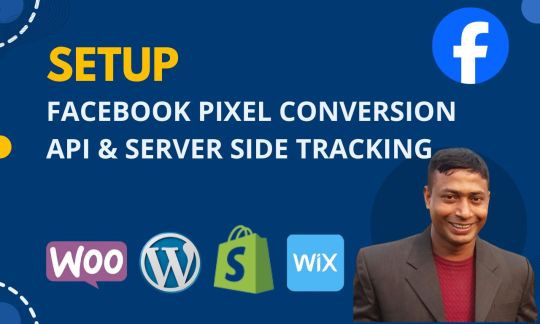
Are you Looking for Setup Facebook Pixel CAPI or GA4 E-commerce Tracking by GTM?
I will setup Facebook pixel, FB conversion API, Shopify ga4 e-commerce tracking by GTM
My Service includes:
=============
✅ Meta Ads Account Setup
✅ Facebook Ads Setup and Management
✅ Campaign Setup
✅ Pixel Setup
✅ Fix the Facebook Pixel error/issue
✅ Deduplication error fix
✅ Setup GTM
✅ Setup All Standard Events ( PageView, ViewContent, AddtoCart, CheckOut, Purchase)
✅ Custom Events Tracking
✅ E-commerce Conversion Tracking
✅ Enable dataLayer
✅ Conversion API
✅ Google Analytics
✅ E-commerce Conversion Tracking
Hire me: https://www.upwork.com/freelancers/~01c51a8a1ba29c68e3?s=1017484851352698999
0 notes
Text

I'm a seasoned digital marketing professional with a robust two-year track record in the field. My expertise spans a spectrum of key areas including Google Analytics 4, Server-Side Tracking, Google Ads Conversion Tracking, E-commerce event tracking and FB Pixel
Here's what I bring to the table:
Proficiency in GA 4 E-commerce Tracking
Seamless GA4 Migration services
Expertise in GA4 Server-side tracking
Google Ads Conversion Tracking and Remarketing
Comprehensive setup of FB Pixel and Conversion API
Resolving issues arising from iOS 14.5 Update
Custom Event tracking encompassing Form Submission, Link Click, Button Click, URL, Mail, Phone No, and Page Tracking
Platforms I work with include:
WordPress
Woo Commerce
Any custom website
Requirements for seamless collaboration:
Google Tag Manager Access
Google Analytics 4 editor access
Facebook pixel access
Google Ads Standard Access
Why choose me?
A steadfast commitment to 100% customer satisfaction
Extensive 3-year experience specifically with WordPress
Ongoing support post-service delivery
Professional-grade solutions at competitive rates
Swift turnaround with options for 1-hour or expedited deliver
Click here https://www.fiverr.com/s/DvekXA
#googleanalytics#googledataanalytics#googleuniversalanalytics#googleanalytics4#googleanalyticstips#googleanalyticscertified#googleanalyticsexpert#googleanalyticsacademy#googleanalyticstraining#.#Created by Inflact Hashtags Generator
0 notes
Text
Ask on WhatsApp: +8801719461325
I will setup facebook pixel through Google Tag Manager, track ecommerce events
WHAT WILL I DO:
Setup Facebook Pixel
All Standard Events Setup through GTM (Purchase> Add To Cart> View Content> Checkout> Lead> Contact etc.)
All Custom Events
Conversion tracking by the Pixel
custom audiences
Lookalike Audiences
Install Google Conversion Tracking with GTM
G Ads Remarketing
G Analytics 4
Setup LinkedIn Insight tag
Pinterest Pixel
#facebook pixel#facebook ads#google tag manager#conversion tracking#setup facebook pixel#pixel#facebook marketing#web analytics#facebook pixel setup#facebook advertising#pixel setup#business manager#event tracking#install pixel#facebook catalog#facebook shop#tracking#remarketing#ios 14 update#fb pixel#facebook bm#fb business manager#instagram shop#shopify pixel#fix facebook pixel#tag manager#pixel on wordpress#fb ads#facebook disabled#analytics
0 notes
Text
Unleashing the Power of Precision: The Role of a Google Tag Manager Expert
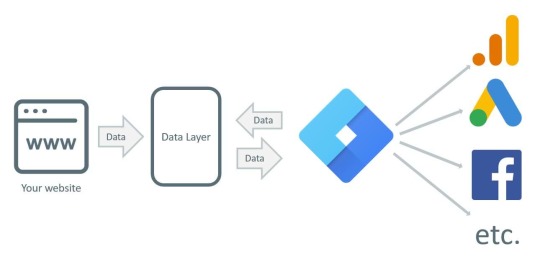
In the complex landscape of digital marketing and analytics, managing and implementing various tags, scripts, and tracking codes can be a formidable task. Enter Google Tag Manager (GTM), a powerful tool designed to streamline the process of deploying and managing tags on your website. However, to truly harness the capabilities of GTM and optimize your tracking efforts, the expertise of a Google Tag Manager expert becomes indispensable. In this blog, we'll explore the pivotal role of a Google Tag Manager expert and why their specialized skills are crucial for maximizing the potential of your online presence.
1. Efficient Tag Implementation:
Google Tag Manager allows for the seamless integration of various tags, including Google Analytics, Facebook Pixel, and custom scripts. A Google Tag Manager expert possesses a deep understanding of how to efficiently implement these tags, ensuring accurate data tracking without the need for constant manual code updates. Their expertise helps in avoiding errors and ensuring a smooth deployment process.
2. Customization for Unique Requirements:
Every business has unique tracking requirements, and a Google Tag Manager expert excels in tailoring solutions to meet specific needs. Whether it's tracking form submissions, monitoring e-commerce transactions, or capturing user interactions, they leverage GTM's flexibility to customize tags and triggers, providing you with precisely the data you need to make informed decisions.
3. Data Layer Optimization:
The data layer is a key component of Google Tag Manager, facilitating the transfer of information between your website and GTM. An expert understands how to optimize the data layer for your specific needs, ensuring that relevant data is available for tags to utilize. This optimization enhances the accuracy and depth of the data collected, contributing to more meaningful insights.
4. Event Tracking Mastery:
Google Tag Manager allows for the tracking of various user interactions, such as clicks, form submissions, and video views. A GTM expert excels in setting up and customizing event tracking, providing valuable insights into user behavior. This data is instrumental in refining your website's user experience and optimizing conversion paths.
5. Debugging and Troubleshooting:
When dealing with a multitude of tags and triggers, occasional issues and discrepancies are inevitable. A Google Tag Manager expert is adept at debugging and troubleshooting, swiftly identifying and resolving any tracking issues. Their proficiency in diagnosing problems ensures that your data is accurate and reliable, laying the foundation for informed decision-making.
6. Version Control and Rollbacks:
As your website evolves, so do your tracking needs. A Google Tag Manager expert utilizes version control within GTM to manage changes systematically. This feature allows for the creation of versions of your container, making it easy to roll back to a previous state if needed. This ensures that changes can be implemented without the fear of disrupting existing tracking setups.
7. Staying Abreast of Updates and Best Practices:
The digital landscape is ever-evolving, and Google Tag Manager is no exception. A GTM expert stays informed about updates, new features, and best practices. Their commitment to continuous learning ensures that your tracking setup remains current and aligned with industry standards.
Conclusion:
In the intricate world of digital analytics, a Google Tag Manager expert is your guiding hand, ensuring that your tracking setup is not just functional but optimized for precision. Their mastery of GTM's features, coupled with a comprehensive understanding of digital analytics principles, positions them as invaluable partners in the success of your online ventures. As you navigate the data-driven landscape, consider the pivotal role that a Google Tag Manager expert can play in unleashing the full potential of your digital analytics strategy.
0 notes
Text
Understanding Facebook Pixel and Its Marketing Applications
In the ever-evolving world of digital marketing, tracking and understanding user behavior is essential to drive effective campaigns and achieve your business goals. This is where Facebook Pixel comes into play. Facebook Pixel is a powerful tool that allows you to monitor user interactions on your website, track conversions, and optimize your advertising efforts. At Digital Orix, the leading web design course in Jaipur, , we understand the importance of leveraging tools like Facebook Pixel to enhance your digital marketing skills. In this blog post, we'll explore Facebook Pixel and its applications in marketing, along with how our web design course can empower you to make the most of this tool.
What Is Facebook Pixel?
Facebook Pixel is a piece of code that you add to your website. It tracks user interactions with your site and provides valuable data that can be used to:
Measure the effectiveness of your ads
Understand how users move through your website
Optimize ad campaigns for specific outcomes, such as purchases or lead generation
Key Marketing Applications of Facebook Pixel
1. Conversion Tracking
Facebook Pixel enables you to track conversions that occur as a result of your Facebook ads. Whether it's a purchase, sign-up, or another desired action, you can measure and attribute these actions to your advertising efforts.
2. Custom Audiences
With Facebook Pixel, you can create custom audiences based on user behavior on your website. For example, you can retarget users who have visited specific product pages but didn't make a purchase, delivering tailored ads to encourage them to return.
3. Lookalike Audiences
By analyzing the data collected by Facebook Pixel, you can create lookalike audiences. These are new users who share similar characteristics and behaviors with your existing customers, expanding your reach to potential customers who are likely to convert.
4. Dynamic Ads
Dynamic ads automatically show the right products to people who have expressed interest on your website. Facebook Pixel tracks the products users view, allowing you to display relevant ads in their Facebook feeds.
Getting Started with Facebook Pixel
Create a Facebook Pixel: Go to your Facebook Business Manager and create a new Facebook Pixel. Follow the setup instructions to generate the Pixel code.
Install the Pixel Code: Add the Pixel code to your website's header section. If you're not familiar with this process, our web design course at Digital Orix can provide you with the necessary skills.
Test Your Pixel: Use Facebook's Pixel Helper browser extension to ensure your Pixel is correctly installed and tracking events.
Digital Orix: Your Path to Web Design Excellence
To excel in web design and digital marketing, including the implementation and utilization of tools like Facebook Pixel, enroll in Digital Orix's web design course in Jaipur. Our course provides comprehensive training in web design, empowering you with the skills and knowledge needed to excel in the digital marketing landscape.
What You'll Learn:
Web design principles and best practices
Implementing and optimizing Facebook Pixel
Crafting effective ad campaigns
Practical experience with web design projects
Personalized mentorship and guidance
Why Choose Digital Orix?
Industry-experienced instructors with expertise in web design and digital marketing
Hands-on, practical web design projects
Personalized mentorship and guidance
Access to industry-standard web design tools
Career support and placement assistance
Maximize the impact of your digital marketing efforts by mastering tools like Facebook Pixel. Contact us today and join Digital Orix's web design course in Jaipur, to gain the skills and knowledge to excel in web design while becoming a digital marketing expert.
In conclusion, Facebook Pixel is a valuable tool that empowers businesses to track user interactions, optimize ad campaigns, and achieve better results in the world of digital marketing. With Digital Orix as your guide, you can become a web designer who excels in implementing and leveraging this essential tool.

0 notes
Text

👉ডিজিটাল কৌশল ছাড়াই কি ব্যবসায় বাড়তে পারে❓
আজকাল সোশ্যাল মিডিয়া মার্কেটিং কৌশল ছাড়া , একটি ব্যবসা বৃদ্ধি অসম্ভব।
তাই আমাকে একটি শীর্ষস্থানীয় কৌশল নিয়ে আলোচনা করতে দিন যা আপনার ব্যবসায়র বৃদ্ধিকে আমূল পরিবর্তন করতে পারে।
প্রায় 2.9 বিলিয়ন সক্রিয় ব্যবহারকারী সহ Facebook হল একটি উপযুক্ত প্ল্যাটফর্ম এবং সঠিক মার্কেটিং এর মাধ্যমে রূপান্তরের জন্য লক্ষ্যযুক্ত গ্রাহকদের পেতে সবচেয়ে সহজ উপায়। যা আপনার ব্যবসার আয় বৃদ্ধির গ্রাফে ঊর্ধ্বমুখী পরিবর্তন করতে পারে।
🎁আমরা ফেসবুক মার্কেটিং সার্ভিস গুলো
👉Facebook business page setup and optimization
👉Run a split / AB Test
👉Advance custom audience setup
👉Facebook Ads Advance Features
👉Choosing proper campaign objectives
👉Advanced pixel setup with Facebook standard and custom events.
👉Remarketing Audience Creation with custom and look-alike audiences
👉Campaign setup with proper funneling (TOFU, MOFU, BOFU)
👉Facebook conversion API setup for server-side Tagging
👉Improve Event match quality and event duplication
👉Use the UTM parameter for Advanced level data tracking in Google Analytics.
আমাদের Facebook মার্কেটিং পরিষেবাগুলি এবং কীভাবে আমরা আপনাকে আপনার অনলাইন মার্কেটিং লক্ষ্য অর্জনে সহায়তা করতে পারি সে সম্পর্কে আরও জানতে বিনামূল্যে পরামর্শের জন্য আজই আমাদের সাথে যোগাযোগ করুন৷
📌 বিস্তারিত জানতে যোগাযোগ করুনঃ
☎️ +8809669260655
📞 +8801743260655
🌐 www.digitalmarketingbd.com
=====Follow Us on Social Media====
⭕Facebook: https://www.facebook.com/DMSBangladesh
⭕Instagram: https://www.instagram.com/DMSBangladesh/
⭕Twitter: https://twitter.com/DMSBangladesh
⭕LinkedIn: https://www.linkedin.com/.../digital-marketing-solution...
⭕Pinterest: https://www.pinterest.com/DMSBangladesh/
⭕YouTube: https://www.youtube.com/c/DigitalMarketingSolution
⭕Tumblr: https://digitalmarketingbd.tumblr.com/
⭕Flickr: https://www.flickr.com/photos/141477915@N04/
⭕Behance: https://www.behance.net/DMSBangladesh
0 notes
Text
Conversion Tracking Strategist GTM, GA4, Google, Facebook, TikTok
Specialise in ⚡Google Tag Manager, ⚡Google Analytics GA4, ⚡Data Studio, ⚡Ecommerce Tracking, ⚡Conversion Tracking, ⚡Cross Domain Tracking.
Order Now- https://www.fiverr.com/share/gjm4jA
🚀 My Services are 🚀
✅Google Ads
● Setup And Optimize The Campaign
● Proper Bidding Strategy For Better Results
● Research Proper Keywords
● Enhanced Google Ads Conversion
● Add Negative Keywords

✅Google Analytics 4
●Install Google Analytics 4 Through GTM
●Track Form Submission
●Button Click Tracking
●Enable Google Signals
●Block Internal Traffic
●Create Audiences For Google Ads Remarketing
●Setup Conversions
●GA4 eCommerce Tracking:
●Custom Reporting & Funnel Analysis
✅Google Tag Manager
●All Kinds Of Tracking
●Facebook Standard Events & Conversion API setup
●GA4 Ecommerce Tracking
●Google Ads Conversion Tracking
●Tiktok Pixel Tracking
●LinkedIn Insight Tracking
●Twitter Pixel Tracking
✅Server Side Tagging
●GA4 Server Side Tagging
●Google Ads Server-Side Tagging
●Facebook Conversion API
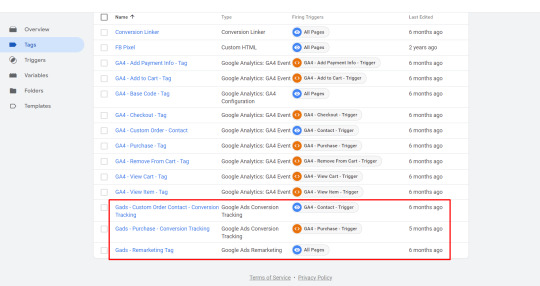
✅Facebook Ads
●Create, Setup & Manage Facebook Ads
●Create A Detailed Buyer Persona for your business
●Setup Aggregated Events Measurement
●Pixel Setup Using GTM
●Conversion API tracking for iOS 14 update setup
●Targeted Audience Research
●A/B Testing Across The Campaigns
●Create Custom & Lookalike Audience
●Campaign Optimization & Reporting
If you have existing issues I will work with you to get them resolved as quickly as possible.
#googleanalytics4 #facebookads #google #googleadwords #googleanalytics4 #ecommercemarketing #eventtracking
#google ads#ecommerce website builder#shopify conversion tracking#google tag manager#facebook pixel#digitalmarketing#facebook ads#google analytics#google tracking#socialmediamarketing#facebook marketing#facebook messenger
1 note
·
View note
Photo
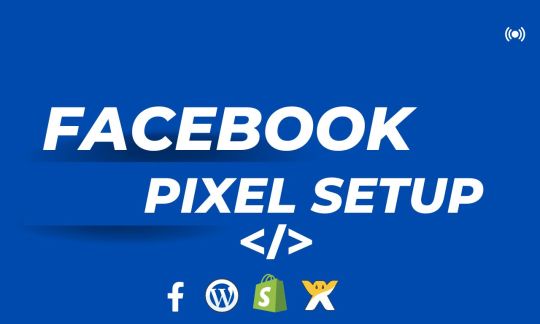
I will setup facebook pixel, fix ios 14 update and conversion ads create
Further detailes:- https://www.fiverr.com/mdsalim1990
FB service:- https://bit.ly/3B69FxW
WhatsApp:- 0601151760365
My services
===========
✅Facebook pixel setup
✅All standard event setup
✅Fix ios 14 update
✅Domain verify
✅FB shop setup
✅Catalog setup
✅Product upload
✅Effective conversion ad create
Whice platform I provide service
Wordpress
Shopify
Wix
1 note
·
View note
Text
Facebook Pixel expert on fiverr
A Facebook pixel installation provides you access to Facebook analytics, which helps you create better data-driven decisions about your online business. You can use the data to improve the results of ads, use retargeting ads, or even improve your website through conversion optimization.
How you can benefit from pixel?
Capturing site visitor data.
Build retargeting lists.
Build lookalike audiences.
low ads cost and high conversion rate.
Setup dynamic ads to reach more potential customers.
My services and qualities include:
Facebook Pixel with custom audiences
Facebook Standard Events
Create Remarketing Audiences
Setup Google Analytics/tag manager
Dynamic ads
Fix pixel issues
platform:
Shopify
WordPress/Woocommerce
Wix
Magento
Joomla
Squarespace
Clickfunnels
1 note
·
View note
Text
How to Use Events to Optimize Your Facebook And Google Ads

Your website is bustling with activity. Visitors are constantly interacting with it.
But are you taking full advantage of everything that’s happening on your website for your paid marketing?
Every interaction a visitor has with your website… a pageview, a click… can be used to better understand your audience.
And when you understand your audience you can target them in a smarter way, and get more bang for your buck from your paid campaigns on Facebook and Google.
Both Facebook and Google refer to these user interactions as Events. They allow you to track them using a tracking code installed on your website.
What Are Events?
Events are user interactions that don’t involve loading another page on your website.
In e-commerce, the prime example of an event is Add to Cart.
Another event can be filling out a field in a form, as opposed to a form completion that usually triggers loading a “thank you” page. Filling out one or more fields without submission (also known form abandonment) can also be recorded as an event.
In essence, you can record any action a user makes as an event, such as watching a video, clicking on a link, or even downloading a PDF.
Why Events Are Important
Events are important because they indicate the intent of your website visitors and which ones are more likely to become a customer or a lead.
If a visitor watched a video on your website, it demonstrates an interest in your offering.
In e-commerce, even if a visitor did not complete a purchase, an abandoned cart shows a high purchase intent. Sure, something has prevented the visitor from completing the purchase, but any visitor who got that far is worth your attention.
By tracking events you’ll be able to make a more focused offer to these users in your paid campaigns.
How you may ask?
By injecting the events tracking data into your paid campaigns and using this data for more precise targeting and an optimized offering.
Think about it, if you can group together all the visitors who watched a certain video and set up a customized campaign for them that referenced what they saw in the video, wouldn’t that make for a far more effective campaign than a generic awareness message?
It sure will.
Let’s discuss how you can use event tracking to get more out of your ad campaigns on Facebook and Google.
How to Set Up Events on Your Website
With both Facebook and Google, you’ll need to use code for setting up events on your website.
So lets go over how you do that…
Setting Up Events Using Facebook’s Pixel
Standard events on Facebook include:
View content
Search
Add to cart
Add to wishlist
Initiate checkout
Add payment info
Make purchase
Lead
Complete registration
Here is the official Facebook guide for setting up events.
First, you need to verify that you already have the Facebook Pixel code embedded in the header code of every page of your website, between the <head> and </head> tags. If you don’t, first go ahead and insert the base Pixel code.
Next, select the event that you wish to track for a specific page from Facebook’s list of events. Let’s say Add to Cart event, which looks like this:
fbq(‘track’, ‘AddToCart’);
Paste the Add to Cart event code above the </script> tag.
Here’s how it should look:

Here’s what each number in the image stands for:
Your header code
Your base Facebook Pixel code (the ID number is unique to every website)
The specific event code
You’ll need to repeat this on every page you want to track one or multiple events. Each page needs its relevant event code.
Event Tracking Setup Using Google Analytics
You can also track events in Google Analytics for even more insight. For event tracking in Google Analytics, you’ll need to create custom code snippets for every event.
Here is the official Google Analytics guide for setting up events.
The code is then added to the link code of the item or action you want to track so when the item is clicked, it will be displayed as an event in Google Analytics.
The event code is made of four elements – two required elements and two optional elements:
Category (required) – defines a group of actions you want to track
Action (required) – the type of action you want to track
Label (optional) – for your monitoring convenience, stating what’s the event is about
Value (optional) – assigning a numeric value to the event; can be monetary value, or just a scale
The basic structure of an event code looks like this:
onclick=”ga(‘send’, ‘event’, ‘Category’, ‘Action’, ‘Label’, ‘Value’);”
The code should be added within the href link code, before the link text:
<a href=”www.examplewebsite.co.uk/pdf/company_brochure.pdf” onclick=”ga(‘send’, ‘event’, ‘PDF’, ‘Download’, ‘Company Brochure – PDF Download’);“>Download Our Brochure</a>
In the example above, no Value was assigned to this event.
There Must Be a Better Way
All this event data needs to be injected into your paid campaigns in order to optimize them but before we get into that, let’s talk about the elephant in the room.
Code!
Dealing with code isn’t ideal for marketers. It’s just not our forte.
It holds us back since constant optimization is one of the core principles of online marketing.
And when you need your development team for every act of optimization, well, it’s not ideal.
Is there a better way to track events on your website? Yes. There’s a tool called Oribi that offers exactly that – no code event tracking.
Oribi tracks every interaction on your website, page views, and button clicks, automatically. It collects all this data and makes it all available to you. Even when you make changes to your website, like adding a page or changing buttons, events are updated dynamically. As said, all of this is done without any code business on your behalf.
Here’s how event tracking looks in Oribi:

The value here is apparent. You don’t need to decide which events to track, and you don’t need your development team to track it for you. Everything is tracked for you. You just need to follow the data.
Using Event Data to Optimize Your Paid Campaigns
Now you can use all this event data that you collected so diligently to better segment and optimize your paid campaigns and get more return on your ad spend.
There are two main objectives for tracking event data:
Internal – being able to analyze how visitors are interacting with your website and from that optimizing the UX (user experience)
External – exporting the data to your paid campaigns to better segment them – group together audiences according to their place in the funnel and specific interests in order to deliver more relevant messages
Let’s look again at the Add to Cart event. As mentioned, adding an item to a cart shows a high purchase intent. These visitors, even if didn’t complete the purchase, declared their interest in your product.
They are ‘worth your efforts’ to continue and court them in the hope they will complete a purchase in the future.
But they are all different, and you can better understand them based on the item, or items, they chose.
If you could, for example, group together all those visitors who added a shirt and then group together those who added a pair of shoes – wouldn’t your customized paid campaigns for these two distinct groups be so much more valuable?
You’ll be able to deliver a highly relevant message, or offering, in your ads.
This is just the tip of the iceberg as far as segmentation and optimization of your paid campaigns that can be achieved with event tracking.
Two Main Use Cases for Ad Campaign Optimization Based on Event Tracking
Both Facebook and Google offer very strong optimization capabilities for their ad campaigns.
There are two objectives for this:
Ability to segment your audience in order to deliver a highly relevant message (the more segmented the audience is, the more relevant your message can be)
Ability to reach new audiences that are also relevant to your offering
Let’s look at how these objectives are achieved through specific features in Facebook and Google ad campaigns.
Facebook’s Retargeting and Google’s Remarketing
The simplest way to explain the Remarketing feature is this:
When you visit a website, a tracking cookie is installed on your browser (yes, that’s the famous cookies message you now see everywhere). After you leave the website, you begin to see display ads from that website.
This is the remarketing feature: it allows advertisers to show you ads of the website you visited on other websites.
The ads can be general, just a reminder of the brand, but they also can be more personalized. The more directly related the ad is to the content you viewed, the impact it will make, thus increasing the likelihood of a purchase or return visit.
Let’s say you browsed a vacation apartments website. You looked at apartments in Lisbon, but didn’t make a reservation. A couple of days later, while scrolling down your Facebook feed, you all of a sudden see an ad that says “Still thinking about Lisbon?”
Now that’s powerful. It will stop your scrolling. It will make you think about Lisbon again. If you clicked the ad, it would take you back straight to the Lisbon section of that vacation apartments’ website.
So by tracking events – in this case browsing a specific page – you are able to deliver highly targeted, super relevant, and hopefully mighty engaging ads to audience that already demonstrated interest in your offering.
Facebook’s Lookalike Audience and Google’s Similar Audience
The simplest way to explain the Lookalike (Similar Audience) feature is this:
Based on your audience attributes, Facebook and Google are able to target similar people and show them your ads.
Behind this simple explanation, there is a highly complex algorithm able to locate people with similar interests, demographics, location, and professional background.
Facebook and Google are able to do this thanks to the vast amounts of data they have on their users.
Let’s say you track a video as an event. The video is a top-of-the-funnel content that explains the benefits of using the app you are offering. Website visitors who watched the video are “recorded.”
You can define the visitors who watched the video as a specific “audience” in Facebook or Google Analytics.
Then, the algorithm finds similarities between the visitors who watched the video and based on this data, can show your ads to other people who never watched the video but share the same similarities with your audience.
This is an incredible tool to expand your potential audience and reach people that are likely to be interested in your offering. This gets you more value on your ad spend.
Connecting the Dots: Events, Audience, and Targeting
So, now you know how Facebook and Google can help you refine and optimize ad campaigns, but what is the process to set it all up?
The first part of the chain is identifying the events and inserting the proper codes for all pages and types of events. We’ve already covered how to set them up, both on Facebook and Google Analytics.
How you define an event is crucial for the success of the campaign and determines which strategy you’ll use either remarketing or a lookalike (similar) audience.
Once you have the events set up, it’s time to connect them to your ad campaign. In this context, “connect” means enabling Facebook and Google to use the data collected from the event tracking to optimize the ad campaign.
Facebook Event Tracking Ad Optimization
Let’s start with the easier of the two.
Once you inserted the event tracking code to the various pages of your website, the events data is available for you on your Ads Manager.
As opposed to Google, where you need to first import the event data from Google Analytics to Google Ads (we’ll get to how to do it in a sec), on Facebook this action is taken care of for you.
Still, you’ll need to locate this data. Here’s how:
First, log in to Ads Manager and click the Pixels tab…

Then, on the left, choose “data sources”, it will take you to your pixel…

Now you’ll see a general breakdown of your events…

And to give you an overview of this report, a few things you should know:
Events received is the total number of events recorded by the pixel
Top events list the highest-performing events
Activity shows the number of events recorded per day for the past week
Now, I want you to click on the “details button”.
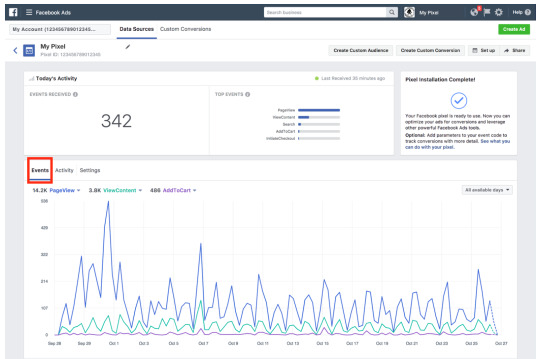
Here you can see the actual breakdown of events, by volume and date. You can segment the visitors based on their actions, as we discussed before, or use the different segmentation for Lookalike audience creation.
Since you are already in Facebook Ads Manager, all the information is available for campaign targeting and optimization.
Google Analytics and AdSense Event Tracking Optimization
It’s a two-step process. First, you need to define the events in Google Analytics, and then import them into Google Ads.
Step #1: Define the event in Google Analytics
In your Analytics account, click the “Admin” tab in the bottom left corner. Then click the “Goals” tab.
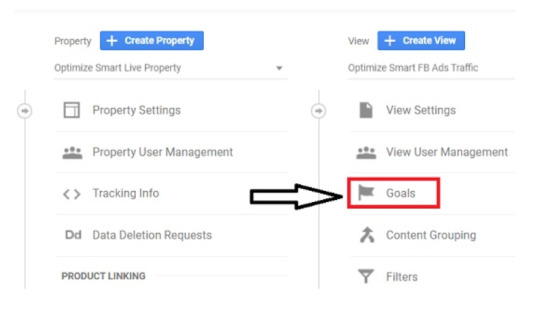
Select “+New Goal”…

Choose the “Custom” option…
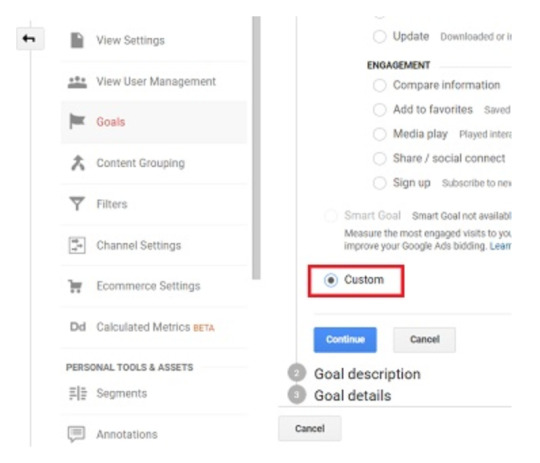
Name your goal…

Select “Event” option…

Now you’ll need to refer to the four elements you defined in the event code you had inserted for the specific event. This:
onclick=”ga(‘send’, ‘event’, ‘Category’, ‘Action’, ‘Label’, ‘Value’);”
The Goal you’re creating will have a specific box for each value. It looks like this:
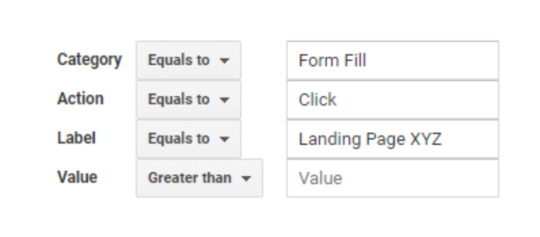
The text you are entering here must be identical to the text in the code. If it won’t, the event won’t be recorded.
You’ll need to repeat the process above with every event you’re tracking.
Step #2: Import the event into Google Ads
In your Google Ads account, click the “Tools” tab at the top navigation bar. Select “Conversions” from the dropdown menu.
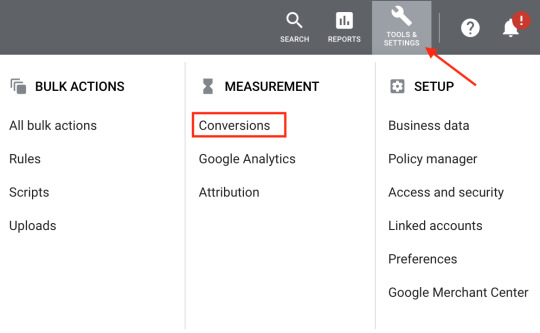
On the left side of the page, click “Google Analytics”…
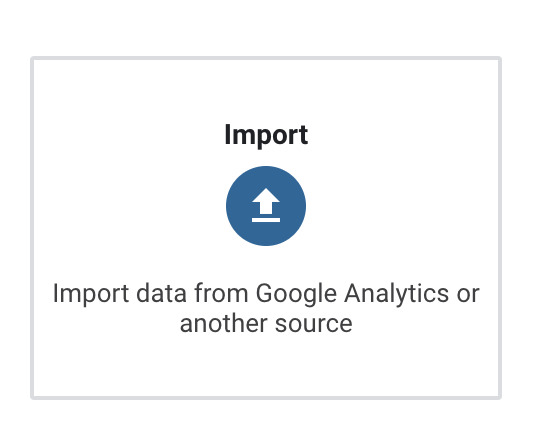
You’ll see a list of all the goals you defined in Analytics…
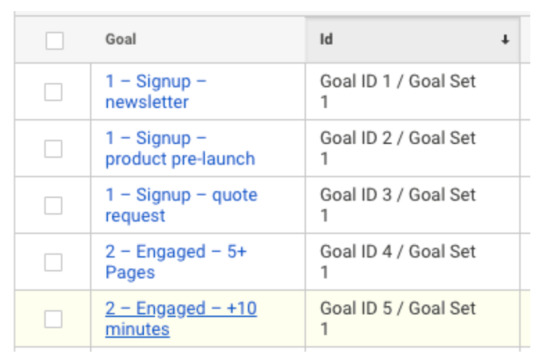
Select the ones you want to import. Then click “Import”.
And you’re done. The events you track on your website are finally available for segmenting your remarketing campaigns and creating similar audiences.
If you don’t want to this yourself, Oribi can also do it for you.
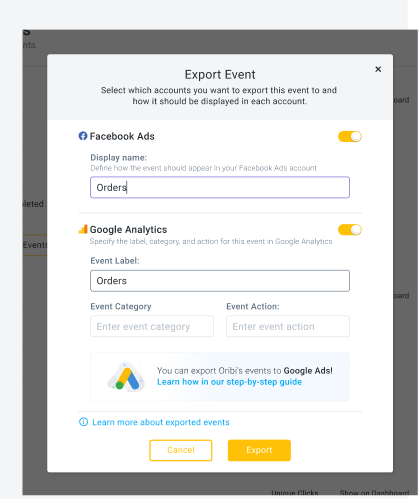
Conclusion
Event tracking provides you with valuable data on your website visitors, such as level of intent, specific interests, and place in the funnel.
This provides better optimization of your paid ad campaigns on Facebook and Google.
You should use event data to deliver highly relevant and effective remarketing ads to segmented audiences who have already visited your website.
You should also use event data as the base for creating lookalike
1 note
·
View note
Text
3 Retargeting Tactics to Enhance Your Digital Marketing
When a search advertising client asks what else he or she could be doing in the digital advertising space, my first thought is typically to tell them about retargeting.
Retargeting perfectly complements search advertising, especially for those clients who offer expensive products and services (think private schools, interior design services, and summer vacation packages).
That said, retargeting is actually a solid fit for any business that wants more visibility and website traffic from highly interested prospects, which can help improve conversions, like calls. And these days, there are a plethora of retargeting options available.
Let’s take a look at some of the most popular and effective retargeting tactics out there.
Search Retargeting
Retargeting isn’t just about keeping one’s brand top of mind among previous website visitors. It can actually boost the effectiveness of search advertising efforts as well.
How, you may be wondering? Well, search retargeting is a specific kind of retargeting that enables businesses to show ads to customers who recently executed a relevant search on Google, Yahoo, or Bing.
Search retargeting allows your ad to piggyback on these search engine queries (think more general searches like “new roof options,” as opposed to more refined searches like “tile roof installers near me”). Then, your ads can display on websites to people who searched for these terms after they leave the search engine.
With any retargeting tactic, it’s important to note that you’re able to target individuals within a tight geographic area (if need be). If most conversions come from within a 15-mile radius around a business, then that same targeting should be applied to a retargeting campaign.
Site Retargeting
One study shows that 98% of consumers leave a site without converting. This statistic alone speaks to why it’s important to incorporate site retargeting into your digital marketing efforts.
Site retargeting is a very familiar, well-established remarketing tactic. The most common setup looks like this:
Business installs a bit of code on its website.
The code drops a pixel on visiting traffic.
Banner creative will appear in front of visitors on a variety of different websites after they leave your site.
Whether website traffic is arriving via social media, directory listings, organic search results, or pay per click ads, the website pixel will drop and retarget website visitors with your ad as they move off your page and browse the web on their desktops or mobile devices.
Facebook Retargeting
Facebook is a great channel through which businesses can retarget visitors. Facebook retargeting works the same way as site retargeting, with the only difference being the site where ads are displayed. Advertising on the social media site gives you the advantage of clear and crisp ads which nestle in with other content (the differentiating feature being a small “Sponsored” label). In addition to the regular ole’ desktop version of Facebook, ads can appear in the mobile app.
By virtue of being on Facebook, a user is typically used to viewing branded content like posts and articles so your prospects may be more likely to click. But unlike a news website or niche blog, social media users scroll quickly through content, so your ads need to be eye-catching to stand out in a busy News Feed.
Hot Tips for Display Ads
Banner and Facebook ads are great for highlighting special events, temporary promotions, and new products. I’ve seen excellent results from ad creatives that offer a percentage discount on items for my clients’ prospects.
It’s important to utilize multiple ad sizes with site and search retargeting efforts. At ReachLocal, we typically utilize about five to eight different sizes of the same banner (perhaps with small variations). In today’s world, you have to consider sizes not just for desktop, but also mobile. In contrast, Facebook ads require a standard size but can stand out with compelling messages and calls to action.
These retargeting tactics are natural additions to your search engine marketing efforts and can help you entice prospects back to your website so they can convert into a customer. Learn more about retargeting on our website.
from http://bit.ly/2O2sppX
1 note
·
View note
Text
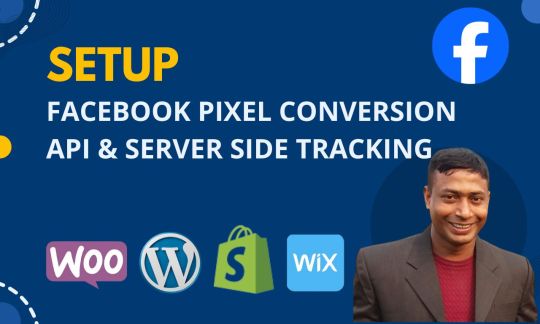
I will setup Facebook pixel, FB conversion API, Shopify ga4 ecommerce tracking by GTM
My Service includes:
=============
✅ Meta Ads Account Setup
✅ Facebook Ads Setup and Management
✅ Campaign Setup
✅ Pixel Setup
✅ Fix the Facebook Pixel error/issue
✅ Deduplication error fix
✅ Setup GTM
✅ Setup All Standard Events ( PageView, ViewContent, AddtoCart, CheckOut, Purchase)
✅ Custom Events Tracking
✅ E-commerce Conversion Tracking
✅ Enable dataLayer
✅ Conversion API
✅ Google Analytics
✅ E-commerce Conversion Tracking
Hire me: https://www.upwork.com/freelancers/~01c51a8a1ba29c68e3?s=1017484851352698999
0 notes
Text
I will bugfix Facebook conversion API, iso14 update with GTM server
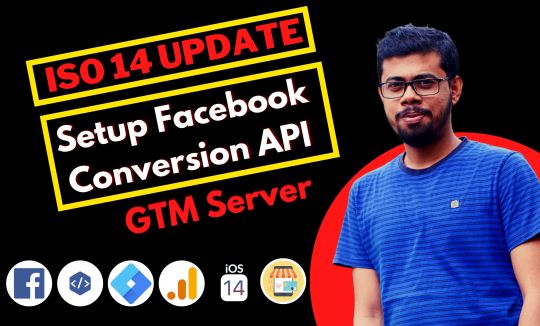
Are you Wondering the iOS 14/14.5 update and other pixel-blockers, cookie blockers, Browser side (ITP) algorithms, will impact your Facebook marketing?
Yes! it's the major problem with Facebook Marketing or e-commerce business For ISO 14 update Safari and Firefox used for (ITP) no longer support third-party cookies for data analysis.
Hi! I'm Raihan. I will set up Facebook Conversion API with GTM Server and Google Analytics 4(GA4) client with GTM to collect all event data.
Facebook conversion API Benefit:
Tracking your website visitors Behavior.
Create custom and Lookalike Audience.
Create Dynamic Remarketing ads.
What I will do for YOU:
Setup FB Pixel CAPI or Server-side tracking with Shopify WordPress and any custom side with GTM web/Server used GA4 client.
Setup FB All Standard Events Tracking (page View, view Content, Add To Cart, Initiate Checkout, lead, Purchase, etc).
Enable event deduplication.
Best event match Quality data for creating custom Audience.
I will enable the Data Layer.
Domain Verification.
I will make unlimited corrections until you are satisfied.
Note:- Client satisfaction is my main purpose
Please contact me before placing an order
Best Regards
Raihan.
#facebook#facebookads#facebook pixel#pixel#serverside#api#iso14#googletagmanager#googleanalytics#ga4#gtm
0 notes
Text
Do You Want to Know How To Add Facebook Pixel To WordPress?
If you add the Facebook pixel to your WordPress website, you can obtain visitor activity data and use it to improve your ad targeting. The Facebook pixel collects information about your WordPress website visitors' actions from the moment they enter your site to the moment they leave it.
What is the Facebook Pixel, exactly?
It is an analytics tool that allows you to measure and optimize your Facebook ads by providing you with data on the actions taken by visitors to your website.
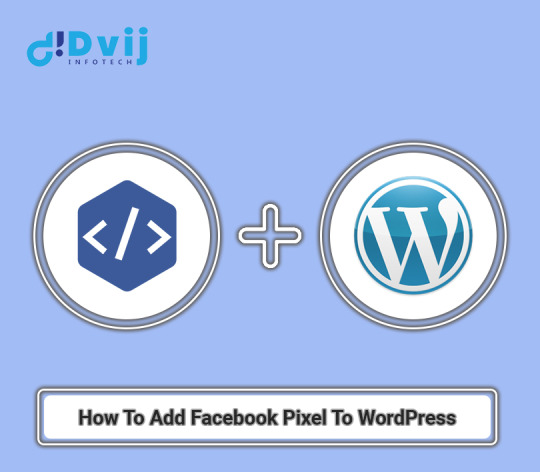
How does the Facebook Pixel function?
Facebook Pixel is a snippet of code that is loaded or fired whenever someone views the content on your landing page or website. The pixel tracks the following to match your website visitors to Facebook/Instagram users.
HTTP headers include IP addresses, web browser information, page location, document, referrer, and the user of the website.
Pixel-specific information includes the Pixel ID and the Facebook Cookie.
Button Click Data: the buttons that a visitor clicks, their labels, and the pages that the visitor opens by clicking the buttons.
Optional Values: You can also use Custom Data events to track conversion value, page type, and so on.
Form Field Names: email, address, quantity, and so on, for use when making a purchase.
You can integrate the Facebook Pixel into your website through WordPress or Facebook's Events Manager.
Facebook Pixel standard events for WordPress
The visitor activities captured by the Pixel assist you in understanding how they interact with your store. These activities include everything from landing on your store to interacting with products to checking out.
Add To Cart: Records information about visitors who add products to their shopping carts.
Add Payment Info: This event is triggered when a visitor enters payment information during the checkout process.
Initiate Checkout: Tracks the activities of visitors who click the checkout button.
Purchase: Tracks when customers finish a purchase and view the "Thank You" page in the checkout flow.
Search: Tracks information about visitors who use the store's search function to find information or products.
View Content: Tracks visitor activity on store pages such as product pages.
We will provide you with a beginner-friendly two different methods :Using Manual Code
Select the pixel you want to configure and then click Continue pixel configuration. Then click Manually install code.
Copy and paste the pixel base code into a new document. Locate the header template in your CMS or web platform, or go to your website's header. Paste the base code at the bottom of the header section just above the closing head tag.
Then press the Continue button. You can add events by using the Event setup tool or manually adding code to your website. Finally, click Done.
Remember to manually enter the code into each of the individual pages where you want the pixel code to appear.
The benefits of using PixelYourSite over the method described above include the ability to easily track conversions, as well as dedicated integrations for WordPress and Easy Digital Downloads. It also makes it easier to set up some of the more advanced aspects of Facebook Pixel and Custom Audiences.
This feature is especially useful if you're using WordPress to power an eCommerce store.
However, even if you only have a regular website, the custom audiences functionality can be useful for advanced Facebook advertisers.
Using Plugin Method
For this, you must first create a Facebook Pixel in Facebook Ads Manager However, you do not need to add the Facebook Pixel to your site because the plugin will do so for you.
Install and activate the PixelYourSite plugin as you would any other plugin.
Then Navigate to the new PixelYourSite section in the WordPress dashboard sidebar.
Next to Your Facebook Pixel, click the Click for Settings button. This will open up some new possibilities. The most important setting here is to enter the Facebook Pixel ID, which can be obtained via the Facebook Event Manager interface.
Aside from that, you can customize the other settings to your liking. If you enable certain settings, you may need to enter some additional information (such as your conversion API token), but the PixelYourSite plugin does an excellent job of explaining how to access all of this information.
You can see the direct links to documentation, such as "watch video" or "how to get it?": Once you've entered your Facebook Pixel ID and made your other selections make sure to save your settings (the save button is at the very bottom of the page).
The benefit of using a plugin is that you can create custom audiences and conversion goals directly from your WordPress dashboard. Because it is dedicated to WooCommerce and Easy Digital, this plugin is especially useful for eCommerce stores.
How you can check whether the pixel is working or not?
To test your pixel, we recommend installing the chrome extension "Facebook Pixel Helper," which will tell you if you have a pixel installed on your website. You can see the following:
You'll be able to see the pixel ID and confirm that it matches the one that appears on your business manager's pixel page.
If you use an ad blocker, make sure you allow it for your website; otherwise, the pixel will not appear even if it is present.
We hope the above steps will help solve the problem of adding a Facebook pixel to a WordPress site.
0 notes
Text
Mastering Digital Tracking: The Strategic Role of a Google Tag Manager Expert

In the ever-evolving landscape of digital marketing, data-driven decision-making is paramount. Google Tag Manager (GTM) has emerged as a powerful tool, streamlining the process of implementing and managing various tracking codes on a website. However, to truly harness the potential of GTM, the expertise of a Google Tag Manager expert is indispensable. In this blog post, we'll delve into the pivotal role that hiring a GTM expert plays in navigating the complexities of digital tracking and optimizing your online presence.
1. Navigating the Google Tag Manager Landscape:
While Google Tag Manager simplifies the process of implementing tracking codes, a GTM expert goes beyond the basics. They possess a deep understanding of the platform's features, triggers, and variables, ensuring that your data tracking is not just functional but also strategically aligned with your business goals.
2. Efficient Deployment of Tracking Codes:
GTM allows for the streamlined deployment of various tracking codes, including Google Analytics, Facebook Pixel, and custom scripts. A GTM expert ensures the efficient and accurate implementation of these codes, preventing conflicts and ensuring that data collection is seamless and reliable.
3. Customized Tracking Solutions:
Every business has unique tracking needs. A GTM expert tailors tracking solutions based on your specific objectives. Whether it's tracking form submissions, e-commerce transactions, or user interactions with specific elements on your website, they create customized setups that provide actionable insights.
4. Cross-Domain Tracking Mastery:
For businesses with multiple online properties, cross-domain tracking is essential for a holistic view of user interactions. A GTM expert navigates the intricacies of cross-domain tracking, ensuring that user journeys across different domains are accurately captured and analyzed.
5. Enhanced E-commerce Tracking:
For e-commerce businesses, understanding customer behavior is critical. A GTM expert excels in implementing enhanced e-commerce tracking, allowing for detailed insights into the entire customer journey—from product views to purchases. This information is invaluable for optimizing your online store and marketing strategies.
6. Event Tracking Expertise:
Events, such as clicks, downloads, and video views, provide valuable insights into user engagement. A GTM expert strategically implements event tracking, capturing relevant interactions that go beyond standard pageviews. This data helps refine your content and user experience.
7. Dynamic Remarketing Implementation:
Dynamic remarketing enables personalized ad experiences based on user behavior. A GTM expert proficiently implements dynamic remarketing tags, ensuring that your advertising efforts are targeted and relevant, ultimately improving conversion rates.
8. Data Layer Management:
The data layer is the foundation of effective data tracking in GTM. A GTM expert adeptly manages the data layer, defining and structuring data to be collected. This meticulous approach ensures that the right information is available for analysis and reporting.
9. Continuous Optimization and Troubleshooting:
The digital landscape is dynamic, and a GTM expert understands the importance of continuous optimization. They monitor data accuracy, troubleshoot issues promptly, and refine tracking setups based on evolving business needs and industry trends.
10. Collaboration and Training:
Effective use of GTM extends beyond technical implementation. A GTM expert collaborates with your team, providing insights and training to empower your internal stakeholders. This collaborative approach ensures that your team can leverage GTM to its full potential.
Conclusion:
In the age of data-driven decision-making, a Google Tag Manager expert is the guiding force that ensures your digital tracking is not just functional but strategically aligned with your business objectives. From efficient deployment of tracking codes to customized solutions, their expertise is the key to unlocking actionable insights that drive your online success. If you're serious about mastering digital tracking and optimizing your online presence, partnering with a Google Tag Manager expert is a strategic move toward data excellence and informed decision-making.
0 notes